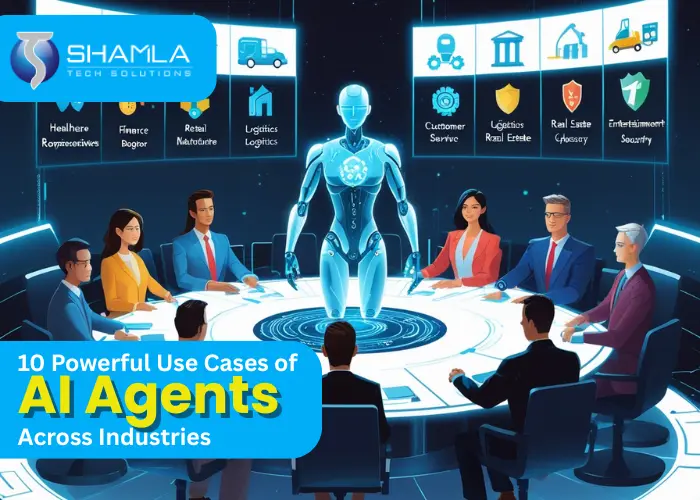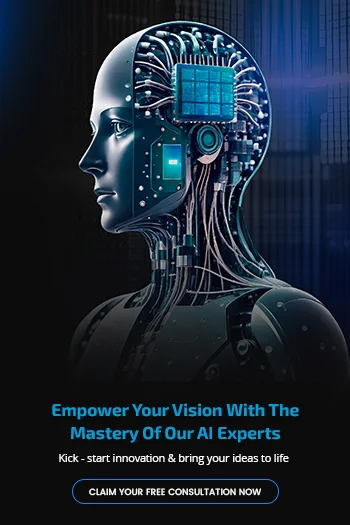10 Use Cases of AI Agents Across Industries
1. AI in Healthcare: Revolutionizing Diagnosis & Treatment
– AI simplifies reading scans by adjusting contrast and brightness automatically, ensuring doctors receive clear images for accurate, swift diagnoses daily.
– Virtual assistants handle appointment scheduling and patient inquiries, reducing wait times while offering friendly, accessible support during treatment planning efficiently.
– Smart systems merge patient data with lab results, providing clear alerts and recommendations that guide doctors towards effective treatment strategies.
– Automated software quickly sorts medical records, ensuring critical details are flagged, stored, and shared accurately among healthcare team members securely.
– AI tools monitor patient symptoms in real time, alerting caregivers instantly when health trends suggest a need for immediate intervention.
– Digital programs help researchers identify new drug combinations by analyzing vast databases quickly, reducing development times and boosting treatment options.
– Simple algorithms predict patient outcomes using past trends, enabling proactive care decisions that improve overall recovery rates and patient safety.
2. AI Agents in Finance: Fraud Detection & Risk Management
– AI systems scan bank transactions in real time, detecting unusual patterns that indicate possible fraud and reducing false positive alerts.
– Predictive models analyze past data to forecast risks, guiding investment choices and ensuring banks maintain steady, safe financial operations efficiently.
– Automated trading systems use clear algorithms that instantly execute trades, minimizing delays and human error while increasing overall market efficiency.
– Robo-advisors offer simple, user-friendly investment guidance, balancing portfolios automatically based on individual risk levels and clear, preset criteria with accuracy.
– Data-driven alerts warn staff of suspicious behavior instantly, using set rules that simplify the process of risk identification and reduction.
– Clear dashboards provide real-time summaries of financial risks, offering simple views and easy-to-understand metrics for fast decision making every day.
– Banks use AI to adjust and improve systems, making smart changes that lead to more secure and steady money operations.
3. AI in Retail: Personalized Shopping & Inventory Management
– Chatbots handle customer queries instantly, reducing wait times and ensuring shoppers receive clear product details and purchase guidance without delay.
– Virtual assistants guide users during online buying, providing simple answers, directing to deals, and smoothing out the shopping journey overall.
– Forecasting tools predict product trends by analyzing past sales data and market behavior, enabling stores to adjust inventory levels accurately.
– Inventory systems use clear data to signal when to restock, reduce excess orders, and maintain a balanced supply chain efficiently.
– Recommendation engines learn from buyer habits, offering item suggestions that match personal tastes and encourage faster purchase decisions online quickly.
– Data systems gather real-time info, helping stores track stock movements, predict trends, and make clear choices for reordering products easily.
– Simple dashboards show sales numbers, stock levels, and buying patterns clearly, so managers can make fast, smart decisions every day.
4. AI Agents in Manufacturing: Smart Automation & Predictive Maintenance
– Robotic process automation handles tasks fast, reducing manual errors and letting workers focus on planning and simple clear decisions efficiently.
– Predictive maintenance checks machines regularly, spotting issues early and preventing breakdowns that lead to high costs and production stops quickly.
– Simple AI vision systems inspect products on lines, catching defects fast and ensuring items meet set quality checks every time.
– Smart sensors gather data continuously, letting managers see clear trends and make simple decisions to keep work smooth and safe.
– Real-time dashboards show production details, guiding workers with clear numbers and helping spot issues before they slow down processes quickly.
– AI tools check parts and work quickly, reducing waste and errors while making sure machines run at steady clear speeds.
– Using simple rules, AI helps spot issues in processes early, saving time and money for companies that work in manufacturing.
5. AI in Customer Service: Enhancing CX with Chatbots & Virtual Assistants
– Chatbots answer user queries instantly using simple pre-set replies, ensuring customers receive clear support without delays or confusing technical terms.
– Virtual assistants guide users through clear, step-by-step solutions, making customer interactions smooth, effective, and easy to understand overall every time.
– Simple sentiment analysis checks user words quickly, understanding feelings and providing clear, tailored responses that improve overall customer service satisfaction.
– Automated call centers handle routine inquiries efficiently, freeing human agents to tackle more complex issues and ensuring constant, round-the-clock service.
– Self-service options empower users to find quick answers online, using simple guides and clear information that make support accessible instantly.
– Data systems track each interaction, storing clear logs and feedback, enabling quick improvements and better understanding of customer needs always.
– Using set rules, AI tools quickly sort and guide common questions, saving time and boosting overall service quality without fuss.
6. AI in Education: Personalized Learning & Virtual Tutors
– Adaptive platforms tailor lessons in real time by analyzing each student’s pace, strengths, and areas needing clear improvement for growth.
– Virtual tutors provide immediate support, answer simple questions, and offer clear step-by-step guidance to boost student confidence with fast results.
– Automated grading systems quickly assess assignments, flag possible copying, and deliver consistent, unbiased results that help teachers focus on teaching.
– AI tutors use basic algorithms to adjust to each student’s needs, ensuring material is delivered in a clear, simple way.
– Data from adaptive tools helps teachers spot trends in learning, allowing adjustments to course content based on clear student feedback.
– Plagiarism detectors use simple checks to compare texts, ensuring work originality and fairness while reducing teachers’ time spent on reviews.
– Clear analytics from adaptive platforms guide educators in making timely changes, creating a focused and easy learning environment for all.
7. AI Agents in Logistics & Supply Chain Management
– AI tools calculate best routes quickly, reducing delivery time and fuel use, which leads to faster service and lower costs.
– Smart sensors track shipments in real time, providing clear updates and reducing wait times in a busy supply chain network.
– Automated systems in warehouses sort goods fast, reducing manual work and errors while increasing clear organization and inventory tracking.
– Data tools forecast product demand by checking past trends and current sales, helping stock managers order items with clear precision.
– AI software accurately suggests restock timings based on clear patterns, ensuring warehouses never run out and keep goods moving smoothly.
– Advanced tools spot risks in supply routes, alerting managers instantly and allowing swift, clear actions to avoid delays or disruptions.
8. AI in Marketing & Advertising: Data-Driven Campaigns
– Customer segmentation uses clear algorithms to divide groups, ensuring targeted ads reach the right audience with precision and fast adjustments.
– Chatbots provide instant replies, reducing waiting times and improving engagement by answering user questions clearly and simply every time swiftly.
– Data analysis tools monitor social trends, create simple content, and adjust ad strategies to boost clear results and brand visibility.
– AI systems generate content quickly, using preset templates and clear keywords to craft ads that connect with users directly effectively.
– Predictive analytics adjust campaigns in real time, tracking data and making clear decisions that improve ad performance and lower costs.
– Automated tools compile audience feedback and ad metrics, allowing marketers to refine strategies and achieve better results with simplicity.
– Clear dashboards present detailed reports on ad performance, letting teams make fast, informed decisions to improve campaigns continuously and quickly.
9. AI in Human Resources: Hiring & Employee Engagement
– AI screens Resumes rapidly, ensuring only qualified candidates are reviewed, reducing manual errors and saving HR teams time every day.
– Automated recruitment systems match candidates with job needs, streamlining hiring processes and delivering clear, fair candidate shortlists efficiently.
– Simple performance analytics track employee progress over time, providing clear insights and data-driven feedback for constant improvement and growth steadily.
– Customized training modules use simple algorithms to tailor learning paths, ensuring workers receive clear, focused skill development opportunities rapidly and effectively.
– Employee engagement tools collect clear feedback continuously, providing real-time data that guides managers to improve team performance simply and fairly.
– Virtual assistants support employees by answering questions quickly, reducing confusion and offering direct help during routine HR processes every moment.
– Real-time dashboards deliver clear, concise reports on recruitment and employee performance, driving smart decisions and improving HR outcomes consistently successfully.
10. AI Agents in Cybersecurity: Threat Detection & Prevention
– AI agents scan network traffic, finding unusual activity by comparing normal data flows with abnormal behavior to stop attacks quickly.
– They run checks on system codes and settings, highlighting gaps that hackers may exploit before causing harm or data loss.
– Simple rule-based filters catch mismatched signals in logs, helping to pinpoint errors and unusual login attempts that indicate breach rapidly.
– AI tools review system details and check user actions, offering clear reports that guide teams to fix found security faults.
– These agents run full security scans and data checks, ensuring each access point is safe and ready against potential attacks.
– They work with simple rules to match correct patterns, detect fraud signs, and verify each user’s true identity quickly and efficiently.
– The system uses clear rules and checks in real time, offering fast alerts and a step-by-step guide for defense measures.



